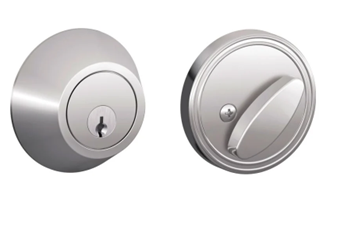Double-Keyed Bolt Locks and Potential Safety Concerns

Bolt locks are not really an exciting topic to write about and they are not something that most homeowners really ever think about, but they should. For over 20 years, I’ve always recommended to my clients that one of the first things they should do after closing is to change all of the locks on their new home’s exterior doors, even in new construction. You never know who else may have a key to the existing locks. It’s an inexpensive and a commonsense security maintenance task that is easy to do and takes maybe 15 minutes per door.
There are 2 types of bolt locks commonly seen in residential homes: the levered type (also called a thumb-latch type) and the double-keyed type. The levered or thumb-latch type is keyed on the exterior side only and has a rotating dial or latch on the interior. You need a key to get in (assuming the lock is engaged) and you can easily unlock the door and exit from the interior by simply turning the latch 90°.


The double-keyed type requires a key to get into or out of the home, assuming the lock is engaged. This is a potential safety issue. In the event of an emergency, a house fire at night time for example, if the key is not in the bolt lock, it may be difficult to locate the key in the dark and smoke in order to get out. You never know where a fire could be in the home, so don’t assume you can access the key in your normal ‘storage spot’ when you’re panicking and time is of the essence. In some cases, breaking a window can be an option for egress in this situation, again assuming you’re not blocked from the closest window by a fire or furniture or stored items. For small children, the elderly, or someone who does not normally live in the home, they may have no idea where the key is stored or may not be able to reach the key. This can lead to someone being trapped in a burning home. Just last month, there was an article published about a house fire and two of the residents were found dead near the front door. It had a double-keyed bolt lock and no key in it and it appeared to the firefighters and the fire marshal investigating afterwards that the victims were trapped in the home.
Section 311.2 of the International Residential Code or IRC (the code used to build new 1 and 2 family homes no more than 3 stories in height) states that: “Egress doors shall be readily openable from inside the dwelling without the use of a key or special knowledge or effort.”
The above requirement for locks at egress doors goes back to, at least, the 2000 IRC although the verbiage was located in a slightly different paragraph of the IRC back then.
Of course, older homes that predate a specific building code are grandfathered in most cases, but safety doesn’t care when the home was built or what code was enforced at that time. Some areas, such as Manheim Township, forbid the front door of any home from having double-keyed bolt locks no matter when the home was built (new or existing). As time goes on, other cities and townships may follow suit for existing homes. Manheim Twp. has a 4-part occupancy permit process when homes are sold there, but a new occupancy permit (and twp. inspection) are not necessarily required every time a home is sold there. If selling a home there, check with the township office. One of the items included in Manheim Twp’s occupancy permit inspection is the bolt lock at the front (primary) door.
Facts, opinions and information expressed in the Blog represent the work of the author and are believed to be accurate, but are not guaranteed. The Lancaster County Association of Realtors is not liable for any potential errors, omissions or outdated information. If errors are noted within a post, please notify the Association. Posts represent the author's opinion and are not necessarily the opinion of the Association.












